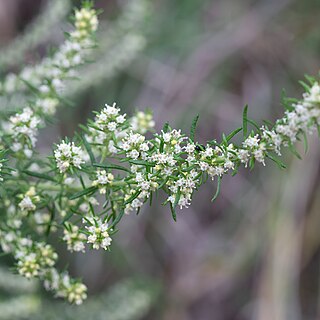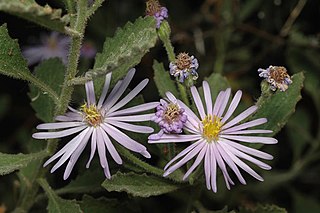
Olearia axillaris, commonly known as coastal daisy-bush, coast daisy-bush or coastal daisybush is a species of flowering plant in the family Asteraceae and is endemic to coastal areas of Australia. It is an erect, bushy shrub with densely cottony-hairy branchlets, aromatic, linear to narrowly elliptic or narrowly lance-shaped to egg-shaped leaves with the narrower end towards the base and small white and yellow, daisy-like inflorescences.

Olearia pimeleoides, commonly known as pimelea daisy-bush, is a species of flowering plant in the family Asteraceae and is endemic to southern continental Australia. It is an erect shrub with elliptic, linear or lance-shaped leaves, and white and pale yellow, daisy-like inflorescences.

Olearia ramulosa, commonly known as twiggy daisy-bush, is a species of flowering plant in the family Asteraceae and is endemic to south-eastern Australia. It is a shrub with narrowly elliptic, linear or narrowly egg-shaped leaves, and pale blue, mauve or white and yellow, daisy-like inflorescences.

Olearia floribunda, commonly known as heath daisy-bush, is a species of flowering plant in the family Asteraceae and is endemic to south-eastern Australia. It is an upright, spreading shrub with egg-shaped leaves and white and yellow or mauve, daisy-like inflorescences.

Olearia myrsinoides, commonly known as silky daisy-bush or blush daisy bush, is a species of flowering plant in the family Asteraceae and is endemic to south-eastern Australia. It is a spreading shrub with hairy branchlets, egg-shaped to elliptic leaves with toothed edges, and white and yellow or mauve, daisy-like inflorescences.

Olearia iodochroa, commonly known as the violet daisy bush, is a species of flowering plant in the family Asteraceae and is endemic to south-eastern continental Australia. It is a shrub with branchlets densely covered with whitish hairs, narrowly egg-shaped leaves with the narrower end towards the base, and white or mauve, and cream-coloured, yellow or blue, daisy-like inflorescences.

Olearia paucidentata, the autumn scrub daisy, is a species of flowering plant in the family Asteraceae and is endemic to the south-west of Western Australia. It is a shrub with variably-shaped leaves, and white, mauve or blue and mauve or yellow, daisy-like inflorescences.
Olearia chrysophylla is a species of flowering plant in the family Asteraceae and is endemic to eastern Australia. It is a shrub with scattered elliptic leaves, and white and yellow, daisy-like inflorescences.

Olearia cydoniifolia is a species of flowering plant in the family Asteraceae and is endemic to eastern Australia. It is a shrub with scattered elliptic leaves, and white and yellow, daisy-like inflorescences.
Olearia elaeophila is a species of flowering plant in the family Asteraceae and is endemic to the south-west of Western Australia. It is a small shrub with scattered linear leaves, and white or blue and yellow, daisy-like inflorescences.

Olearia ferresii is a species of flowering plant in the family Asteraceae and is endemic to central Australia. It is an erect, aromatic shrub with elliptic to lance-shaped leaves and white and yellow, daisy-like inflorescences.
Olearia imbricata, commonly known as imbricate daisy bush, is a species of flowering plant in the family Asteraceae and is endemic to the south-west of Western Australia. It is a shrub with small, overlapping linear leaves and bluish-purple or white, daisy-like inflorescences.
Olearia lehmanniana is a species of flowering plant in the family Asteraceae and is endemic to inland areas of the south-west of Western Australia. It is a shrub with scattered elliptic or linear leaves that are densely hairy on the lower surface, and pale mauve, daisy-like inflorescences.

Olearia muricata, commonly known as rough-leaved daisy bush, is a species of flowering plant in the family Asteraceae and is endemic to the south-west of Western Australia. It is an erect shrub with flat, linear to triangular leaves, and white or pale mauve and yellow, daisy-like inflorescences.
Olearia picridifolia, commonly known as rasp scrub-daisy, is a species of flowering plant in the family Asteraceae and is endemic to southern continental Australia. It is a low, spreading shrub with narrowly egg-shaped or narrowly elliptic leaves, and blue, mauve or white and yellow, daisy-like inflorescences.

Olearia ramosissima, commonly known as much-branched daisy bush, is a species of flowering plant in the family Asteraceae and is endemic to continental Australia. It is a straggly shrub with densely-crowded, elliptic, egg-shaped or triangular leaves, and blue to violet and blue or yellow, daisy-like inflorescences.
Olearia strigosa, commonly known as bristly daisy bush, is a species of flowering plant in the family Asteraceae and is endemic to the south-west of Western Australia. It is an erect shrub with linear leaves and blue or purple, daisy-like inflorescences.

Olearia subspicata, commonly known as spiked daisy bush or shrubby daisy-bush, is a species of flowering plant in the family Asteraceae and is endemic to continental Australia. It is an erect shrub with more or less linear leaves and white and yellow, daisy-like inflorescences.

Olearia tubuliflora, commonly known as rayless daisy-bush, is a species of flowering plant in the family Asteraceae and is endemic to south-eastern continental Australia. It is a slender, erect shrub with linear or narrowly elliptic leaves and yellow, daisy-like inflorescences but with the ray florets lacking a ligule.

Olearia xerophila is a species of flowering plant in the family Asteraceae and is endemic northern Australia. It is an erect subshrub with elliptic to broadly elliptic leaves and violet, blue or mauve and yellow, daisy-like inflorescences.















